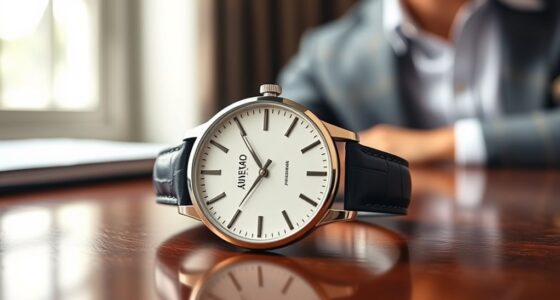Rolex's closure of the 137-year-old watch brand Carl F. Bucherer comes after a strategic acquisition in 2023. The brand struggled with financial losses and fierce competition, failing to carve out a niche in the crowded luxury market. With over 250 million CHF invested without success, Rolex aims to streamline its offerings and enhance its direct-to-consumer approach. Curious about how these changes affect the watch industry? You'll find more insights as you explore further.
Key Takeaways
- Rolex acquired Bucherer in 2023, aiming to enhance its retail presence and direct-to-consumer strategy.
- Carl F. Bucherer faced persistent financial struggles, failing to achieve profitability despite significant investments.
- The brand's lack of market recognition hindered its competitiveness against established luxury watch brands.
- Closure impacted around 100 employees, with some transitioning to Rolex's new manufacturing facility in Switzerland.
- Rolex's strategic shift focuses on streamlining offerings and repurposing resources for enhanced brand presence.
The Acquisition of Carl F. Bucherer by Rolex

In 2023, Rolex took a bold step by acquiring Bucherer, which included the historic watch brand Carl F. Bucherer, renowned for its 137-year legacy in luxury watchmaking.
This strategic move aimed to enhance Rolex's retail presence and strengthen its direct-to-consumer approach through Bucherer's extensive network of over 100 global sales outlets. Additionally, the acquisition highlights the importance of strategic withdrawals for maintaining financial health in a competitive market.
However, the acquisition wasn't without its challenges. Despite Rolex's investment and vision for the brand, Carl F. Bucherer faced ongoing financial struggles, failing to turn a profit throughout its history.
Competing against established luxury brands like Omega and IWC proved intimidating.
Ultimately, Rolex's decision to shut down the brand marked a significant shift in the luxury watch market, reflecting the complexities of brand management in today's competitive landscape. Additionally, this situation underscores the importance of proper planning when navigating financial investments and acquisitions in the luxury sector.
Financial Struggles Leading to Closure

Despite its long-standing heritage, Carl F. Bucherer (CFB) faced significant financial struggles that ultimately led to its closure.
Despite heavy investments of around 250 million CHF, the brand never achieved profitability. CFB struggled to carve out a niche in the competitive luxury watch market, often overshadowed by more prominent names like Breitling and Omega. The brand's inability to implement a retirement savings plan for its future investments compounded its financial issues.
Millions in debt, the brand's lack of brand awareness hindered its ability to generate sufficient revenue. Attempts to modernize its offerings failed to resonate with consumers, leading to ongoing financial losses. In an economic climate where precious metals investment is often seen as a safer alternative, Rolex's decision to shut down CFB reflected the brand's inability to sustain operations as a viable business in the luxury watch sector, marking the end of an era.
Impact on Employees and Brand Legacy

As Rolex closes Carl F. Bucherer, the impact on employees and brand legacy is profound. Approximately 100 employees face uncertainty, though many will shift to Rolex's new factory in Bulle, Switzerland. This decision not only marks the end of CFB's 137-year legacy but also affects the watch industry at large.
- Employees experience job shifts, with some finding new roles at Rolex.
- The Bucherer family's long-standing influence in watchmaking concludes. Additionally, the closure highlights the importance of long-term financial planning for employees transitioning to new opportunities.
- CFB's unique offerings will be sorely missed by loyal fans.
- Rolex's focus on brand performance overshadows CFB's historical significance.
Ultimately, this closure reflects Rolex's ambition, leaving a complex legacy intertwined with the memories of a cherished brand. Additionally, the decision may also influence air purifier maintenance practices among luxury brands as they adapt to market changes.
Market Competition and Challenges

The closure of Carl F. Bucherer highlights the fierce market competition faced by luxury watch brands today. Despite investing around CHF 250 million, CFB struggled to establish brand recognition, making it tough to stand out among giants like Breitling, IWC, and Omega. In a landscape where AI integration in healthcare is improving diagnostics accuracy, luxury brands must also leverage technology to enhance consumer engagement.
With around 350 points of sale globally, the brand couldn't achieve the necessary awareness to attract consumers. Its proprietary movements, while technically impressive, failed to resonate emotionally, leading to disappointing sales. Ultimately, the lack of distinct appeal and recognition in a crowded luxury watch market played a vital role in Rolex's decision to discontinue the brand. For CFB, the challenges proved insurmountable in a world dominated by stronger, more established competitors. Additionally, the rise of AI-powered marketing strategies has made it increasingly difficult for new entrants to compete effectively.
Rolex's Strategic Shift Post-Acquisition

With its acquisition of Carl F. Bucherer, Rolex's decision to discontinue the brand marks a significant strategic shift in its luxury watch portfolio.
This move reflects several key factors:
- Ongoing financial losses that never yielded profit despite an estimated investment of CHF 250 million.
- A focus on enhancing Rolex's own brand presence through a streamlined product offering, which aligns with the need for prioritizing tasks that contribute most to overall success.
- A pivot towards a direct-to-consumer model, improving insights into product performance and customer preferences.
- The repurposing of resources and workforce for manufacturing needs at the new factory in Bulle, Switzerland.
This strategic shift not only reinforces Rolex's stringent brand performance standards but also positions the company for future growth and efficiency. Additionally, Rolex's emphasis on maximizing investment returns aligns with the luxury market's demand for high-quality and desirable products.
Frequently Asked Questions
What Will Happen to Carl F Bucherer?
Carl F. Bucherer will cease operations, marking the end of its historic legacy.
You'll see around 100 employees shift to Rolex's new factory in Bulle, Switzerland.
The brand's retail presence will gradually close, as boutiques either shut down or are replaced by other names.
If you own a CFB watch, don't worry; Rolex plans to honor warranties and service support, ensuring you'll receive assistance even after the brand's closure.
Does Rolex Confiscate Stolen Watches?
Yes, Rolex does confiscate stolen watches.
When you report a stolen Rolex, the brand works closely with law enforcement to maintain a database and help recover these timepieces.
If Rolex gets a stolen watch returned, they verify its authenticity and ownership before taking any action.
Their commitment to combating watch theft guarantees that you receive genuine products, and they endeavor to reunite recovered watches with their rightful owners whenever possible.
What Is the Oldest Watch Brand?
If you're curious about the oldest watch brand, it's Breguet. Founded in 1775 by Abraham-Louis Breguet in Paris, this iconic brand is known for its significant innovations, including the tourbillon and the first wristwatch.
You'll find that Breguet's legacy has greatly influenced the luxury watch industry. Alongside brands like Vacheron Constantin and Audemars Piguet, Breguet continues to produce exquisite timepieces, celebrating its rich heritage in modern horology.
Is Carl F Bucherer Owned by Rolex?
You won't believe it, but Rolex now owns Carl F. Bucherer! After acquiring the brand in 2023, Rolex intended for it to operate independently.
Unfortunately, despite the rich history and investment, CFB couldn't turn a profit, leading to its closure.
Rolex is now focusing on strengthening its own brand while shifting the affected employees to new opportunities.
Conclusion
In closing the doors on Carl F. Bucherer, Rolex didn't just extinguish a brand; it dimmed a flicker of horological history. The echoes of craftsmanship and legacy fade, leaving employees and enthusiasts grappling with a deep sense of loss. As Rolex pivots toward a new horizon, the shadows of competition loom larger, reminding us that even the mightiest can stumble. This decision, while strategic, feels like a bittersweet farewell to a cherished chapter in watchmaking.









